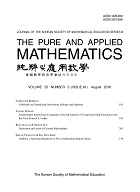 ISSN : 1226-0657
ISSN : 1226-0657
권호 목록
- 2024 (31권)
- 2023 (30권)
- 2022 (29권)
- 2021 (28권)
- 2020 (27권)
- 2019 (26권)
- 2018 (25권)
- 2017 (24권)
- 2016 (23권)
- 2015 (22권)
- 2014 (21권)
- 2013 (20권)
- 2012 (19권)
- 2011 (18권)
- 2010 (17권)
- 2009 (16권)
- 2008 (15권)
- 2007 (14권)
- 2006 (13권)
- 2005 (12권)
- 2004 (11권)
- 2003 (10권)
- 2002 (9권)
- 2001 (8권)
- 2000 (7권)
- 1999 (6권)
- 1998 (5권)
- 1997 (4권)
- 1996 (3권)
- 1995 (2권)
- 1994 (1권)
19권 1호
초록
Abstract
We study surfaces of revolution in the three dimensional Euclidean space <TEX>$\mathbb{R}^3$</TEX> with two distinct axes of revolution. As a result, we prove that if a connected surface in the three dimensional Euclidean space <TEX>$\mathbb{R}^3$</TEX> admits two distinct axes of revolution, then it is either a sphere or a plane.
초록
Abstract
The fuzzy time series is introduced by Song and Chissom([8]) to construct a pattern for time series with vague or linguistic value. Many methods using the interval and fuzzy logical relationship related with historical data have been suggested to enhance the forecasting accuracy. But they do not fully reflect the fluctuation of historical data. Therefore, we propose the interval rearranged method to reflect the fluctuation of historical data and to improve the forecasting accuracy of fuzzy time series. Using the well-known enrollment, the proposed method is discussed and the forecasting accuracy is evaluated. Empirical studies show that the proposed method in forecasting accuracy is superior to existing methods and it fully reflects the fluctuation of historical data.
초록
Abstract
Given a set <TEX>${\Omega}$</TEX> and the notion of bipolar valued fuzzy sets, the concept of a bipolar <TEX>${\Omega}$</TEX>-fuzzy sub-semigroup in semigroups is introduced, and related properties are investigated. Using bipolar <TEX>${\Omega}$</TEX>-fuzzy sub-semigroups, bipolar fuzzy sub-semigroups are constructed. Conversely, bipolar <TEX>${\Omega}$</TEX>-fuzzy sub-semigroups are established by using bipolar fuzzy sub-semigroups. A characterizations of a bipolar <TEX>${\Omega}$</TEX>-fuzzy sub-semigroup is provided, and normal bipolar <TEX>${\Omega}$</TEX>-fuzzy sub-semigroups are discussed. How the homomorphic images and inverse images of bipolar <TEX>${\Omega}$</TEX>-fuzzy sub-semigroups become bipolar <TEX>${\Omega}$</TEX>-fuzzy sub-semigroups are considered.
초록
Abstract
We give an elementary proof of Descartes' theorem for polyhedra. Since Descartes' theorem is equivalent to Euler's theorem for polyhedra, this also gives an elementary proof of Euler's theorem.
초록
Abstract
By simply splitting the hypergeometric Saran function <TEX>$F_E$</TEX> into eight parts, we show how some useful and generalized relations between <TEX>$F_E$</TEX> and Srivas- tava's hypergeometric function <TEX>$F^{(3)}$</TEX> can be obtained. These main results are shown to be specialized to yield certain relations between functions <TEX>$_0F_1$</TEX>, <TEX>$_1F_1$</TEX>, <TEX>$_0F_3$</TEX>, <TEX>${\Psi}_2$</TEX>, and their products including different combinations with different values of parameters and signs of variables.
초록
Abstract
In this paper, we prove the stability in random normed spaces via fixed point method for the functional equation <TEX>$$f(x+y+z)-f(x+y)-f(y+z)-f(x+z)+f(x)+f(y)+f(z)=0$$</TEX>. by using a fixed point theorem in the sense of L. C<TEX>$\breve{a}$</TEX>dariu and V. Radu.
초록
Abstract
This is a survey on the volume entropy and its rigidity of various metric spaces. This survey is aimed to summarize recent results as well as remaining open questions and possible directions on this subject.
